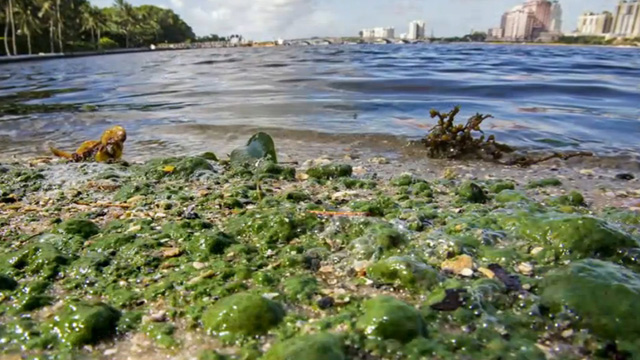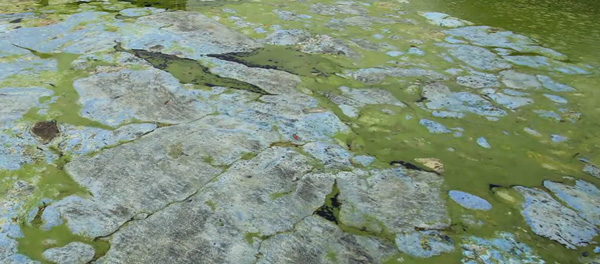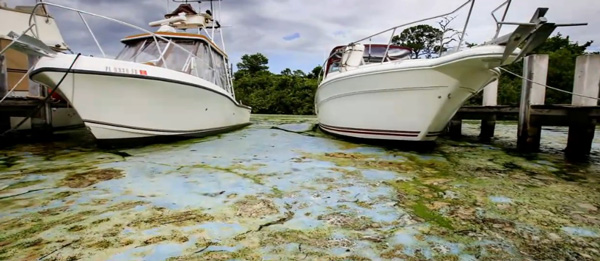Florida beaches invaded by dangerous algae caused by farm fertilizers: respiratory problems, skin rashes and more
Friday, July 08, 2016 by: Wes Maxwell
Tags: toxic algae, biosolids, beaches

(NaturalNews) A state of emergency has been declared in four counties in Florida due to the formation of excessive toxic algae in the state's ocean waters. After having to temporarily shut down a slew of Florida beaches over July 4th weekend because of the presence of algae, the problem has since escalated, and put not just the health of Florida's pristine beaches in peril, but the health of its inhabitants as well.
This "living, putrid green slime" has been reported to make Florida's beaches "smell like a toilet," and has caused a myriad of health issues including headaches, rashes and respiratory issues. The toxic algae first started forming when authorities released water from Lake Okeechobee into a series of canals draining into the ocean two weeks ago.
Lake Okeechobee, like many other lakes in the U.S., has been known for its rampant blooming of dangerous algae. While the mainstream media reports that the algae blooms are being caused by farm fertilizer run-off, evidence suggests another culprit could be to blame.
Sam Shepherd, a chemical engineer with expertise in pathology, told Natural News exclusively that biosolids have been applied near the site of contamination responsible for the dangerous algae.
Biosolids, a treated form of sewage waste combined with toxic waste from various industries, has justifiably been scrutinized for its adverse environmental effects, with land application in Florida being no exception.
Officially classified as a waste material, biosolids are generated when solids accumulated during domestic sewage processing are treated further to meet mandatory regulatory requirements. Essentially the sewage industry's corporate lobbyist term for "sewage sludge", biosolids have been placed in mass quantities around the country since the 1970s.
Lake Okeechobee is no exception. According to Sam Shepherd, "Class B biosolids have been placed around the farmlands of Lake Okeechobee for up to 50 years ... and it will take another 50 years to clean it up."
In light of extensive research in the state of Florida about the environmental and health risks of biosolids, The Overview of DEP's New Biosolids Rule stated that the placement of biosolids in certain designated sites was expected to cease entirely by the year 2013. Interestingly enough, Lake Okeechobee was one of those designated sites. Currently, only about half of such sites have ceased operations.
Although biosolids are treated to pass federal regulations, they more often than not still contain dangerous bacteria and other harmful pathogens. According to Food Safety News, biosolids "regularly tests positive for a host of heavy metals, flame retardants, polycyclic aromatic hydrocarbons, pharmaceuticals, phthalates, dioxins, and a host of other chemicals and organisms."

Photo credit: ABC News

Photo credit: ABC News
Dr. David Lewis, a former EPA scientist, reported directly to Natural News that some of the known human health effects of biosolid exposure include: shortness of breath, mucus in the lungs, skin rashes and other respiratory issues. Coincidentally, many of the aforementioned symptoms are not too dissimilar to the symptoms experienced by those exposed to the algae blooming on Florida's beaches.
Additionally, Dr. David Lewis's book, Science For Sale, links biosolids to increases in antibiotic resistance, perhaps providing a cause for ABC News' reports of serious infections afflicting Florida inhabitants exposed to the ocean's algae outbreak.
Furthermore, Newsweek reported earlier this year that the presence of biosolids in livestock grazing pastures has the potential to cause grave human health-related consequences. "Given that these chemicals are very persistent," Richard Lea, a reproductive biologist at the School of Veterinary Medicine and Science at the University of Nottingham, wrote, "and they've survived the very intensive processing of the sewage to begin with, there's a very high chance they'll end up inside us."
No one knows exactly what happens to the leftover contaminants in biosolids once they are placed into soil, but there is more and more evidence suggesting it cannot be good. To uncover the truth about exactly how detrimental biosolids are to human health, calls for independent lab testings are crucially important. Whether biosolids are the cause of Florida beaches' toxic algae problem remains to be seen for certain, but the dots continue to line up, and Florida's beaches continue to look like ghost towns. Check back for updates.
Sources:
Hindawi.com
ABCNews.Go.com
FoodSafetyNews.com
Dep.State.FL.US[PDF]
Amazon.com
Europe.NewsWeek.com
Toxic algae at FETCH.news
Get independent news alerts on natural cures, food lab tests, cannabis medicine, science, robotics, drones, privacy and more.
Take Action: Support Natural News by linking to this article from your website
Permalink to this article:
Embed article link: (copy HTML code below):
Reprinting this article:
Non-commercial use OK, cite NaturalNews.com with clickable link.
Follow Natural News on Facebook, Twitter, Google Plus, and Pinterest
- Four supplements that will benefit almost everyone
- The REAL FAKE NEWS exposed: '97% of scientists agree on climate change' is an engineered hoax... here's what the media never told you
- The United Nations 2030 Agenda decoded: It's a blueprint for the global enslavement of humanity under the boot of corporate masters
- Staged Zika pandemic was engineered by globalist governments to justify the aerial bombardment of awakening populations with toxic chemicals
- BPA makes breast cancer tumors resistant to chemotherapy
- New Studies Reveal the Medicinal Benefits of Honey
- News coverage about a flawed omega-3 study reveals truth about media's inaccurate health reporting
- Australia bans flu vaccines in children after vomiting, fevers, seizures
- Sunflower seeds: a good source of fiber, protein, vitamin E and more
- A Holistic Approach to Treating the Symptoms of Diverticulitis
- Doctors against vaccines - These physicians actually did the research
- Five simple steps to detoxing your body of disease-causing mercury and heavy metals
- What to look for when choosing a probiotic supplement
- Soy consumption linked to tumor growth in breast cancer
- The downfall of science and the rise of intellectual tyranny
- Shock findings in new GMO study: Rats fed lifetime of GM corn grow horrifying tumors, 70% of females die early
- First time ever: Medical doctor speaks out about reversing cancer, Lyme and autoimmune disease naturally
- Why Obama's Health Care Reform Bill Will Destroy U.S. Jobs and Devastate the Economy
- The REAL FAKE NEWS exposed: '97% of scientists agree on climate change' is an engineered hoax... here's what the media never told you
- Before his death, father of ADHD admitted it was a fictitious disease
- Canadian agency attacks Jenny McCarthy for demanding mercury-free vaccines
- Vaccines lower immunity
- Red Cabbage Found to Contain 36 Anti-Cancer Anthocyanins
- The truth about tanning beds: They boost vitamin D production
- Raw Broccoli, Cabbage Slash Bladder Cancer Risk by 40 Percent; Cooking Destroys Benefits
- Bill Gates says vaccines can help reduce world population
- Beat cancer with 35% hydrogen peroxide
- Apricot Seeds Kill Cancer Cells without Side Effects
- First fatality of the robot apocalypse? Robot grabs factory worker and crushes him to death
- Get the benefits of mega-dose IV vitamin C without IVs - by yourself
- The best and worst forms of magnesium to take as a supplement
- Flu vaccines causing massive spike in deaths of elderly across the UK, warn health officials
- Vaccines cause autism: Supporting evidence
- Zeolite detox myths busted: In lab tests, zeolites do NOT bind with aluminum, lead, uranium, mercury or cadmium... only CESIUM
- How turmeric kills cancer and how to optimize curcumin absorption
- Blaming dietary sodium for high blood pressure is too simplistic; the real problem may be mineral deficiencies
- The REAL FAKE NEWS exposed: '97% of scientists agree on climate change' is an engineered hoax... here's what the media never told you
- Red Cabbage Found to Contain 36 Anti-Cancer Anthocyanins
- Beat cancer with 35% hydrogen peroxide
- Bosnia war survivor warns of things to come in collapse of America
- Apricot Seeds Kill Cancer Cells without Side Effects
- The United Nations 2030 Agenda decoded: It's a blueprint for the global enslavement of humanity under the boot of corporate masters
- Dandelion root extract found to kill leukemia cells, prostate cancer cells and chemo-resistant melanoma
- Forget Filling Cavities: Regrow Your Teeth Instead
- Use these 5 powerful herbs to boost your immune system
- The best and worst forms of magnesium to take as a supplement
- Untested vaccines causing new wave of polio-like paralysis across India
- Before his death, father of ADHD admitted it was a fictitious disease
- Vitamin E kills off cancer cells and prevents their reproduction, study finds
- The 5 best natural antibiotics and anti-virals that destroy superbugs and just about everything else
- Canadian agency attacks Jenny McCarthy for demanding mercury-free vaccines
- Bill Gates says vaccines can help reduce world population
- Vaccines lower immunity
- Top foods, herbs and supplements to keep on hand in the event of a nuclear crisis
- EPA advisor admits the agency is funneling billions to climate groups ahead of Trump’s return to White House
- Newly released JFK files reveal Pentagon's role in creating Lyme disease and covid in the same lab
- Eleven days before Iran bombed Tel Aviv, my microscope revealed haunting images of EXACTLY what would happen
- Morphic resonance “remote viewing” reveals iconic Middle East images of stealth bombers, a falcon and a one-horned ram
- Two containers with completed ballots fall out of truck in Florida
- Mike Adams releases country western hit single: Goin’ Back in Time is Comin’ Home
- DECENTRALIZED SPIRITUALITY and the true teachings of Christ: Overcoming the censorship, threats and lies of organized religion to truly know God and the Universal Christ
- Global leaders unite to clamp down on “misinformation” with UN-backed Cascais Declaration
- BOMBSHELL: Covid-19 mRNA nanoparticles EMIT LIGHT SIGNALS that communicate MAC addresses used for self-assembly inside the blood vessels
- I Want My Bailout Money – new song released by Mike Adams
- HEALTH SECRETS: How to Instantly Block MSG Toxicity Using Natural Substances (and the secret of Methylene Blue)
- The Health Ranger releases “Vaccine Zombie” song and music video, using AI-animated zombies for the music video
- HYSSOP: What research reveals about the health benefits of this ancient holy herb
- BOMBSHELL: Internal Pfizer documents exposed and reveal at least 16 PERCENT of their mRNA vaccine "adverse events" are REPRODUCTIVE DISORDERS
- BOMBSHELL: DNA testing kits are a SCAM to develop ethnic-specific bioweapons
- Scientists confirm: GENIUS brain function can be spontaneously unleashed in humans without any apparent cause
- Amazing microscopy photos reveal how freezing crystals attempt to mimic electronic structures they are touching
- RFK Jr. clears key hurdle: Sen. Susan Collins backs controversial HHS nominee, signaling a new era for health policy
Science News & Studies
Medicine News and Information
Food News & Studies
Health News & Studies
Herbs News & Information
Pollution News & Studies
Cancer News & Studies
Climate News & Studies
Survival News & Information
Gear News & Information
News covering technology, stocks, hackers, and more



"Big Tech and mainstream media are constantly trying to silence the independent voices that dare to bring you the truth about toxic food ingredients, dangerous medications and the failed, fraudulent science of the profit-driven medical establishment.
Email is one of the best ways to make sure you stay informed, without the censorship of the tech giants (Google, Apple, Facebook, Twitter, YouTube, etc.). Stay informed and you'll even likely learn information that may help save your own life."
–The Health Ranger, Mike Adams























